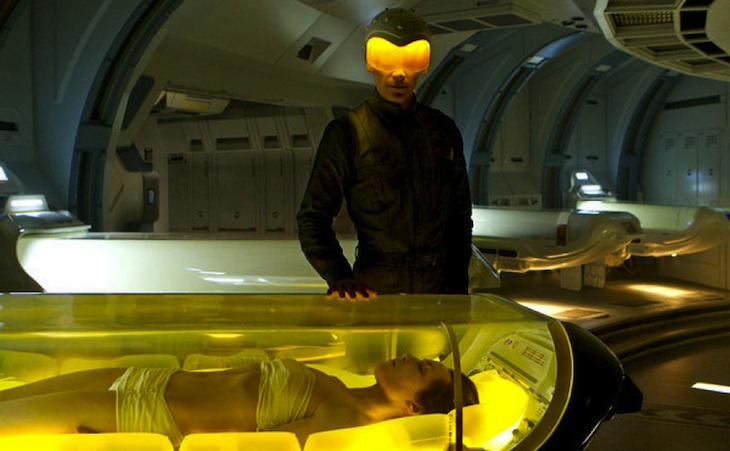

The first astronauts who head off to Mars might make the entire 180-day journey while they’re fast asleep. In a NASA-commissioned study on human stasis, aerospace engineers at SpaceWorks have found that the benefits of placing a crew in suspended animation for the duration of the journey could be legion. Without living spaces or kitchen facilities, the ship carrying the crew could be lighter and smaller. With everyone basically in hibernation, with a lower metabolic rate, future missions can reduce consumables like food and water by up to 70 percent. And having an unconscious crew also reduces the grueling boredom and chances of personality clashes before humanity can complete the small step/giant leap onto the Red Planet.
It sounds practically perfect in every way, but there’s still a considerable amount of time and research that needs to happen before we send astronauts off to Mars via the shores of sleep. The technology that SpaceWorks is looking at is a form of therapeutic hypothermia that will drop the temperature of the astronauts’ bodies by just 5 to 10 degrees Fahrenheit, reducing their metabolism and putting them in a kind of hibernation. “It doesn’t take much to get the body to start slowing down,” says John Bradford, President of SpaceWorks Enterprises.
Though it involves chilly temperatures, therapeutic hypothermia is a hot topic in the medical world, with numerous published studies and trials in the works, all trying to buy trauma patients an increased chance of recovery on the surgeon’s table. Bradford says that SpaceWorks has been paying close attention to the studies coming out of the medical world, and that they think therapeutic hypothermia could be used safely on interplanetary flight, once some of the medical concerns of such an endeavor are studied and addressed.
One of the biggest issues facing human stasis using therapeutic hypothermia involve the simple fact that the method has only been tested in people who have been severely injured. “Nobody has done this on a healthy person,” Bradford says, making it hard to isolate what benefits or problems the method could pose for astronauts in peak condition. Not only that, but the longest medical trials of therapeutic hypothermia have only lasted for 14 days, and a mission to Mars will take at least 180 days for a one-way journey.
Some of the other medical questions that therapeutic hypothermia faces:
- Cognitive function—How will being unconscious for six months affect the human brain, and how long will recovery take? “Is it going to be a couple hours, a couple days?” Bradford says, adding: “We’d like to measure how well you can perform when you get there.” A recovery time on the scale of months would obviously be problematic. Bradford says that initial results from case studies showed that some patients who underwent therapeutic hypothermia actually preformed better cognitively after the procedure than before. Then again, before the procedure, those patients were severely injured, so it’s hard to say how astronauts would react.
- Muscle atrophy and bone loss—Staying in shape is hard enough for astronauts and cosmonauts who are awake. But add being completely sedentary to a weightless environment and the threats of muscle atrophy and bone loss become much more severe. To counter the physiological effects, Bradford says that astronauts in stasis will be treated with drugs to counter the bone loss, and their muscles will be given an electrical workout, stimulated by small electrical impulses. “We can envision that you’re constantly being exercised in this manner,” Bradford says.
- Intracranial pressure—One of the more enigmatic challenges faced by long-term spaceflight projects is the effect of intracranial pressure on astronauts. Researchers have noticed that without gravity, fluids in the body tend to move towards the upper body, raising pressure in the skull, and affecting vision. Bradford says that some medical studies have found that induced hypothermia can reduce cranial pressure in situations here on earth, which gives him hope that it could have a beneficial impact on astronauts.
- Radiation—Exposure to radiation is a huge challenge to long distance spaceflight, but Bradford hopes that stasis using hypothermia could reduce the risk. A summary of the proposed method from SpaceWorks says: “Testing in animals has shown that cancerous tumor growth and the effects of radiation are significantly reduced and slowed during the torpor-state (on par with metabolic rate reduction).” In addition, the savings on mass (no living quarters, less food, etc) mean that a transport vessel using stasis could theoretically be heavily armored against radiation in a way that a larger vessel could not.
Bradford says that the next phases of research will involve longer term testing on animals, then humans, and eventually, humans in space– likely on the ISS. He’s optimistic that with all the ongoing medical tests on therapeutic hypothermia, a viable solution for the Mars mission will be available well before any Mars projects get off the ground. “A space application is just part of it. Instead of developing some niche technology, we’re going to leverage something that’s existing,” Bradford says.
And, just for the record, unlike many science fiction plots where something goes wrong and the capsule containing the astronauts is left to float in space for centuries, if something were to go wrong on a Mars mission using stasis, the hibernation system would automatically shut off, waking the crew and allowing them to make necessary repairs.
